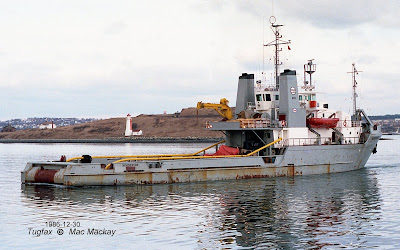After an active year or two for offshore supply vessels, Halifax has now entered another drought, which shows little sign of improvement in the near term. As with the rest of the world, oil exploration and development has hit the skids and huge numbers of support vessels and drill rigs have been stacked. Halifax was a bit of an anomaly due to Shell's exploration drilling off Nova Scotia using the drill ship
Stena ICEMAX.
However that troubled program turned up disappointing results on top of all the difficulties and the drill ship has moved on to its next assignment. (It is currently anchored in Las Palmas). The three suppliers used to support it are all now idled in Halifax.
Skandi Flora and
Maersk Nexus are tied up at the IEL and Mobil docks in Dartmouth, and
Scotian Sea at the old Coast Guard base (see
Shipfax January 30). The standby boat
Atlantic Tern is idled at pier 9C also. There are no prospects in the offing unless Shell is forced to pick up the abandoned drill stem it dropped on the ocean floor a year ago.
BP also has plans for an exploration program in 2017, but details are scarce. In view of the world situation for this type of vessel, they may be laid up for some time.
Meanwhile both offshore gas facilities are experiencing problems. Encana's Deep Panuke is winding down to seasonal operation due to low process and water issues, but the supplier
Atlantic Condor and standby
Atlantic Tern remain employed
..
The other Sable Island area gas project, the Sable Offshore Energy Project (SOEP) (Exxon Mobil are the lead operators) has
Venture Sea and
Siem Hanne contracted. The project began production in 2013 but is not expected to last out its projected 13 year lifespan. The supplier
Trinity Sea has been laid up in Dartmouth for several months.
Meanwhile at Halifax Shipyard the two newbuilding suppliers
Atlantic Griffon and
Atlantic Shrike have completed their first sea trials and bollard pull*tests. They continue fitting out at pier 9B, still in the hands of Damen, their builders. No date has been announced for handover to Atlantic Towing Ltd, but I am told that the third of the four tug order is en route to Damen's home shipyard in the Netherlands for its final trials.
There have been slow downs like this in the past as the oil industry is notorious for hills and valleys, but the current depressed market has seen numerous business failures and restructurings and still shows only faint glimmers of any sort of recovery.
Just astern of the new suppliers in the photo above, the cable ship
Isaac Newton is in layup. Its operators, Dredging and Maritime Management SA (DMM SA) have applied for another coasting license for 2017. Apparently the ship did not complete its work on the New Brunswick / Prince Edward Island power cable project before the onset of winter. It is expected to resume work March 15 and complete by June 15.
* Bollard Pull
For many years bollard pull trials were conducted in Halifax off the end of Pier 22 where there is a large, deeply rooted bollard, known as the "Queen Mary Bollard". There is one of these huge concrete filled steel bollards at each end of the seawall, at Pier 20 and Pier 22. They were installed when the seawall was built to accommodate the largest ships of the time, which was pre-
Queen Mary, but that name has been used for many years. I probably have some more recent or clearer photos of the bollards, but due to present day security restrictions I can't get near enough to take any pictures now.
The Pier 20 bollard at the north end of the seawall looked like this in 1970:
The bunkering tanker Imperial Cornwall is delivering some Bunker C fuel to the Nova Scotia Light + Power generating station (now the Nova Scotia Power Corp head office) and the Pier 20 Queen Mary Bollard sit in the foreground. It is large, deeply set in and surrounded by a working area.
The water is deeper and there is lots of sea room off the end of Pier 23.
The south Queen Mary bollard is directly above the wheelhouse of the Canada Pilot No.4 as it speeds into port. The Italian passenger liner Leonardo DaVinci is making its approach to pier 21- mid-berth on the seawall. A Russian trawler occupies the south end of pier 22 and another ship is tied up at pier 20 in the background.
Numerous Georgetown-built tugs conducted their bollard pull trials off pier 22.
Atlantic Bear at full power off Pier 22. The tow line has been sheathed where it might chafe on the stern rail.
Océan Raymond Lemay is set off diagonally from the corner of Pier 22 to prevent prop backwash from effecting the trial results. A fender is being swept away from the pier by the wash.
Pier 22 is not accessible to vehicles, so it is more convenient to conduct trials off the end of pier 26. There is an equally large mushroom head bollard there, which would prevent the line from slipping off. I probably have a photo of it somewhere, but it is no longer accessible to unauthorized persons such as I.
Seven Seas Mariner glides in past the end of Pier 26. The yellow bollard is set back from the corner of the pier providing room for the load cell measuring device. (There is also a yellow railway bumper partially blocking the view.)
Here is a blow up:
Yellow rail bumper, mushtoom bollard, light pole and fire hydrant occupy the end of the pier.
.






























